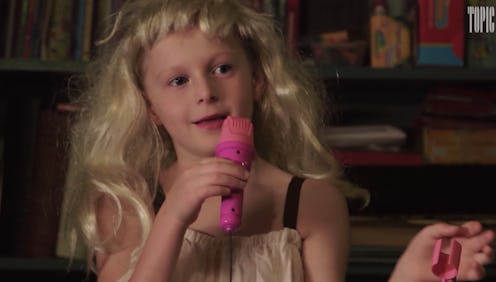Life
This Is What It’s Like To Grow Up Genderqueer In The Rural South In 2017
Since the 20th century, the LGBTQ community has made massive strides toward equality. In the United States, some of the most recent milestones in the fight for LGBTQ rights include the legalization of same-sex marriage, or Washington D.C.'s recent decision allowing residents to choose gender-neutral options on their driver's licenses. Policy and stats, however, don't paint the full picture of what it's like to be LGBTQ today in America.
Pink Boy, a documentary directed by Eric Rockey and featured on Topic as part of its Female Trouble Mixtape series, shows one genderqueer child’s experience living in the rural South, and illustrates what it's like to grow up LGBTQ in a conservative part of our nation. What is a surprise and delight about this short film is just how much joy the protagonist, Jeffrey, expresses, in spite of prejudices people around the child might have. Though the film came out in 2015, it's especially relevant to watch now as the Trump administration seeks to role back protections for transgender people, especially transgender children.
The short doc begins with Jeffrey, the six-year-old subject of the film, wearing a blonde wig and dress, singing into a toy microphone for the camera. While panning between images of Jeffrey playing in traditionally "feminine" clothing and the small town outside of Tallahassee where the child lives, Jeffrey's great-aunt and primary caretaker, BJ, says, “When I agreed to take Jeffrey, part of it was that he was a boy. I was interested in raising him because he was a boy.”
Jeffrey’s great-aunt gained custody of Jeffrey when the child was only two months old from her niece. She goes on to explain how her own childhood had been traumatic due to on-and-off involvement of child protective services, so she felt compelled to raise Jeffrey. As Jeffrey’s great-aunt recounts the first time she bought Jeffrey a dress, she tells the filmmakers she wouldn’t allow the child to wear it publicly because she feared dangerous backlash from “conservative folks.” (The second-grader's family uses he/him pronouns to refer to Jeffrey, who presents as genderqueer at home and in public as safety permits.)
BJ is “hypervigilant" about Jeffrey's safety due to the discrimination and bullying she herself faced as a lesbian in the rural south. Throughout Pink Boy, it seems as though Jeffrey’s family must constantly balance their child's safety with respect for Jeffrey’s gender identity. Jeffrey shyly nods “yes” as BJ asks, at one point in the film, if kids at school laugh at Jeffrey for wearing dresses.
One can’t help but feel sad when BJ explains that Jeffrey enrolled in karate classes at only four-and-a-half years old to learn self-defense. On one hand, the extent to which the family looks out for their child's safety is remarkable; but on the other, it's upsetting that in our society, we need to teach four-year-olds self-defense because of their gender identity.
In the moments where Jeffrey is able to openly present as queer, especially through dressing up and dancing, the child exudes genuine happiness. The documentary captures an especially important event: Jeffrey’s first Halloween where the six-year-old is allowed to dress up as a princess.
But the most poignant moment in Pink Boy is when Jeffrey’s great aunt asks, "What do you want to be when you grow up?" Jeffrey simply responds, “a girl.” Like every other six-year-old kid, genderqueer or not, Jeffrey is just learning and exploring what it means to be themselves. The scenes in Pink Boy — from Jeffrey rock climbing at a fall festival, to riding a tricycle — serves to remind the audience that Jeffrey is just a normal child who has been othered by society.
Though the short film is a mere 15 minutes long, it echoes a common experience shared by genderqueer children across the United States. Stories like Jeffrey's —where freedom of gender is celebrated amid a conservative environment — underscore the fact that LGBTQ acceptance has come far, but there's still so much work to be done. Since pediatricians typically do not ask their patients about their gender identity, it is difficult to pinpoint the exact number or percentage of children who identify as genderqueer or non-binary; even without exact statistics, a recent survey showed 50 percent of kids believe gender is a spectrum.
While more widespread acceptance is a step in the right direction, our society can’t ignore that 86 percent of LGBTQ youth report being harassed, bullied, or taunted at school. The Trevor Project, a national organization providing suicide prevention and crisis intervention for LGBTQ youth, reports that lesbian, gay, and bisexual youth are four times more likely to commit suicide than their straight peers. This suicide risk increases dramatically for transgender youth, with 41 percent reporting they have attempted suicide. Our society must continue to work toward making sure genderqueer children stay safe, and we must improve the quality of life for all LGBTQ kids like Jeffrey.
You can watch Pink Boy in full at Topic, where it's part of a series of short films on women who cause "trouble."
